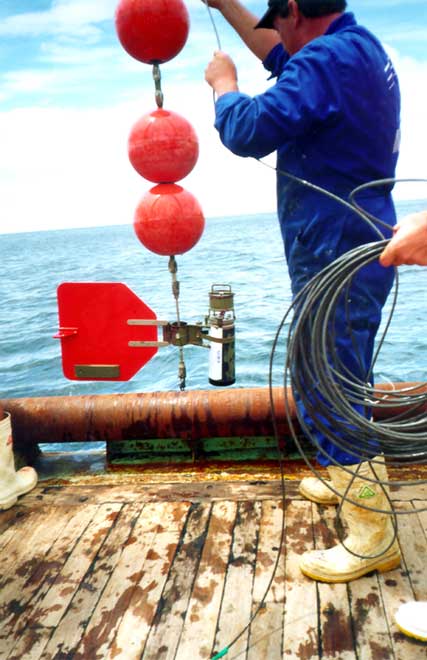
A scientific mooring, with sensors attached, is lowered into the ocean to collect information about ocean currents. Craig Stevens reports on a mooring found half buried in sand, on the coast near Hokianga Harbour entrance.
What\'s you story?
Contributed by Craig Stevens of Wellington.
I belong to the physical oceanography group at the National Institute of Water and Atmospheric Research, and one of our key jobs is oceanographic mooring. This involves sinking a long cable to the seabed, with very expensive scientific sensors arrayed along its length. These moorings may stay out for a year or more, collecting information about ocean currents.
Our moorings actually have no floats on the surface. Instead we sink them with weights, and subsurface floats hold the mooring line reasonably vertical under the water. To get the mooring back we use an acoustic ‘pinger’ to send a message to the mooring to let go of the heavy ballast and float to the surface.
In 2004 we received an email: ‘A farmer has found some cables and tubes washed up on a beach in the Hokianga Harbour. Do you have any gear out in the water up that way?’
We were interested. Actually, we were really interested. Only a few days previously our research vessel, the 75-metre Tangaroa, had been off the coast at Hokianga recovering a sequence of scientific moorings. In the process, one mooring had gone missing.
Occasionally something goes wrong: maybe the mooring is long gone – dragged away by a trawler; maybe the release device has failed; or maybe the cable has been bitten by a big fish. Truth be told, these moorings are quite well described as ‘cables and tubes’ so we were quietly excited when we heard the news.
We contacted the farmer and he described finding the gear, how it was partially buried in sand, and his efforts to recover it. It sounded like our equipment, so a field team drove over from Whangārei, filled up the ute and shipped the gear back to our laboratory in Wellington, where we hoped to retrieve the data.
In these days of USB pen-drives and DVD data-disks holding gigabytes, we still have the odd bit of field gear that uses magnetic tapes. This particular mooring was one of the old ones, with magnetic tapes inside. Our specialist carefully rinsed and dried the tape and placed it in our ancient tape reader, and to his amazement the data were still readable! There’s no way a modern electronic device would have survived this treatment.
If you ever find a bunch of tubes and cables washed up on a beach, give us a call.
Using this item
NIWA – National Institute of Water and Atmospheric Research
This item has been provided for private study purposes (such as school projects, family and local history research) and any published reproduction (print or electronic) may infringe copyright law. It is the responsibility of the user of any material to obtain clearance from the copyright holder.






Add new comment